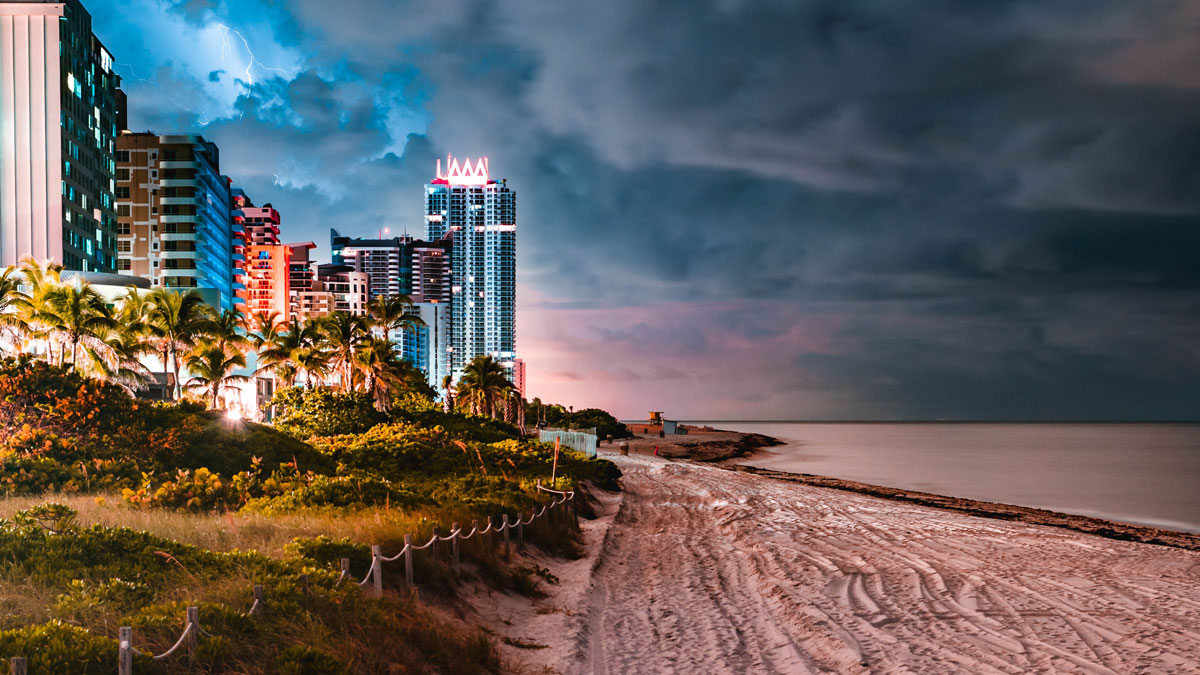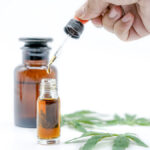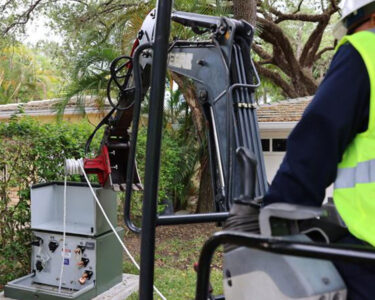Whether you’re a first-time Floridian, or have weathered a few storms, the 2020 hurricane season is guaranteed to be a little different.
There’s now a chance for one disaster to layer upon another. Federal scientists expect this years’ storms to be more frequent and powerful, with two named storms having formed before the official start of the season. Meanwhile, the University of Washington’s Institute for Health Metrics and Evaluation is projecting more than 100 new coronavirus infections a day in Florida by August 1, just as the hurricane season starts to peak.
As our nation and state slowly creep out of quarantine, the standard hurricane question of, “Should I stay, or should I go?” now includes a pandemic plot twist. Plus, standard steps for preparation, and even recovery, will take much longer, if available at all.
The good news, Florida’s State Administration and national emergency resources are also acutely aware of these potential dangers, and are doing everything in their power to prepare and plan ahead. With a few simple steps, here’s how everyone can get ahead of the blustery curve.
- Stock supplies responsibly.
- Do it early and safely. Start immediately if you haven’t already, as everything these days takes longer than usual. Use home delivery or curbside services where possible, considering unique needs for your family like medications, pet food or vitamins. Most importantly, take only what you need. We all witnessed toilet paper turn to currency overnight during the last raid, no sequel necessary.
- Limited Resource Tips
- Consider purchasing large collapsable water carriers instead of bottled water or disposable jugs. Fill these 5- and 10-gallon vats with filtered or tap water from your home, then refill your personal bottles or cooking pans as needed. Made of non-toxic and BPA-free heavy duty polyethylene, you can roll them up and reuse them year after year.
- No disinfectant wipes? No problem. Did you know the CDC has DIY recipes and videos to make your own disinfectant spray from everyday household materials (which you can wipe with a clean cloth or paper towel). Visit cdc.gov to learn how.
- Let’s make plans.
- Plan, plan, and then plan some more. Know your home and group’s capability and enact the plan for one level above the predicted landfall category. Try to consider all possible outcomes. What if the storm moves inland? Where will you go in an evacuation? Are there multiple routes? What about furry family members? Grandparents? Neighbors? Also consider what you will do if a member of your party becomes ill during the period leading up to, during or after the storm.
- Update your survival kit.
- In addition to the staples like food, water, batteries, cash and fuel, we now need to add COVID personal protection items to the supply stash. Include at least two cloth face coverings per family member, general household cleaning supplies to disinfect surfaces, hand sanitizer and soap, disposable latex gloves, and eye coverings. Also ensure additional first-aid supplies if a family member falls ill, like a thermometer, over-the-counter medication and comfort items.
- Seek socially-distanced shelter.
- The term itself is a massive contradiction, but given a choice between saving a life or risking a life-threatening virus, the former must take precedence. The American Red Cross is already lining up hotels and dormitories, plus a higher number of large spaces so evacuees can be spread out. “There will be health screening and temperature checks to get into shelters,” says Trevor Riggen, a Red Cross senior vice president. “People with temperatures or virus risk factors will be accommodated in a separate location with access to medical help,” he said. Food will be served in boxes instead of cafeteria-style, and the Red Cross has already stockpiled face coverings and disinfectants for shelter cleaning. Download both the FEMA and ReadyMDC app ahead of time for up-to-date info and evacuation center locations.
- Evacuate like an expert.
- If you need to get in the car and drive, or even catch a flight, know the rules of the road best travelled. Know your route, and hopefully a backup as well. In public restrooms, be careful not to touch fixtures after washing your hands. Pay with credit cards where possible, not cash, to eliminate face-to-face interaction (plus cards can be sanitized). For meals, try for sit-down meals in outdoor dining areas, or use drive-through and takeout where possible. If you need to stay somewhere overnight, many hotels have made improvements like hospital-grade disinfectants and contactless check-in. For added protection, use your own sanitizing supplies on high-touch surfaces in an airplane or hotel room, and forgo housekeeping and food services.
- Expect delays.
- As the economic reopening creeps along, everything is slower than usual, and probably will be for a while. Book the landscaping and handyman preparations now. Expect longer than usual power outages after a storm, which could mean you need more than the previously recommended 72-hour supply stash of food, water, fuel and batteries. Also expect medical responsiveness to be delayed or altered during or after a storm. This might mean you need additional prescription or over-the-counter medical supplies on hand. Also, get acquainted with your medical providers’ online, phone or app services.
- Get back to basics.
- Amid all the added steps needed to manage a potential disaster within a disaster, don’t forget the simple stuff. You’ve already planned ahead and packed supplies for days, even weeks. Be sure to also properly prep your property, ensuring safe window coverings, removal of possible projectiles, and additional vehicle storage. Also ensure your insurance for your home and belongings is up-to-date for wind and flood occurrences. Take important documents and keepsakes to a high point or along with you, and also snap photos of all property and possessions well ahead of time.
The 1-2-3’s
Learn the notable numbers predicted by NOAA and CSU (National Oceanic and Atmospheric Administration and Colorado State University)
- 60% chance for an above-normal season
- 70% chance of having 13 to 19 named storms (Tropical storms are given names when they display a rotating circulation pattern with wind speeds of 39 miles per hour
- Six to ten storms could develop into hurricanes (over 74mph sustained winds)
- Of those, three to six storms could develop into major hurricanes (Categories 3-5, over 110 – 157mph or higher sustained winds).
- 70% chance of a major hurricane making landfall along the U.S. coast, with a 46% chance along the East Coast and Florida peninsula, a 45% chance along the Gulf Coast, and a 59% chance in the Caribbean.
- All probabilities are roughly 15% above the averages for the last century
- The official Atlantic Hurricane Season is June 1 – November 30
The ABC’s
Get to know the names of this year’s Atlantic storm systems, a few already introduced.
- Arthur (named May 12)
- Bertha (named May 27)
- Cristobal (named June 2)
- Dolly
- Edouard
- Fay
- Gonzalo
- Hanna
- Isaias
- Josephine
- Kyle
- Laura
- Marco
- Nana
- Omar
- Paulette
- Rene
- Sally
- Teddy
- Vicky
- Wilfred














 Deering Estate
Deering Estate
 Massage Envy South Miami
Massage Envy South Miami
 Calla Blow Dry
Calla Blow Dry
 My Derma Clinic
My Derma Clinic
 Sushi Maki
Sushi Maki
 Sports Grill
Sports Grill
 The Healthy Kitchen
The Healthy Kitchen
 Golden Rule Seafood
Golden Rule Seafood
 Malanga Cuban Café
Malanga Cuban Café

 Kathleen Ballard
Kathleen Ballard
 Panter, Panter & Sampedro
Panter, Panter & Sampedro
 Vintage Liquors
Vintage Liquors
 The Dog from Ipanema
The Dog from Ipanema
 Rubinstein Family Chiropractic
Rubinstein Family Chiropractic
 Your Pet’s Best
Your Pet’s Best
 Indigo Republic
Indigo Republic




 ATR Luxury Homes
ATR Luxury Homes


 2112 Design Studio
2112 Design Studio
 Hamilton Fox & Company
Hamilton Fox & Company
 Creative Design Services
Creative Design Services
 Best Pest Professionals
Best Pest Professionals
 HD Tree Services
HD Tree Services
 Trinity Air Conditioning Company
Trinity Air Conditioning Company
 Cisca Construction & Development
Cisca Construction & Development
 Mosquito Joe
Mosquito Joe
 Cutler Bay Solar Solutions
Cutler Bay Solar Solutions


 Miami Royal Ballet & Dance
Miami Royal Ballet & Dance
 Christopher Columbus
Christopher Columbus
 Pineview Preschools
Pineview Preschools
 Westminster
Westminster
 Carrollton
Carrollton
 Lil’ Jungle
Lil’ Jungle
 Frost Science Museum
Frost Science Museum
 Palmer Trinity School
Palmer Trinity School
 South Florida Music
South Florida Music
 Pinecrest Orthodontics
Pinecrest Orthodontics
 Dr. Bob Pediatric Dentist
Dr. Bob Pediatric Dentist
 d.pediatrics
d.pediatrics
 South Miami Women’s Health
South Miami Women’s Health

 The Spot Barbershop
The Spot Barbershop
 My Derma Clinic
My Derma Clinic




 Miami Dance Project
Miami Dance Project

 Rubinstein Family Chiropractic
Rubinstein Family Chiropractic
 Indigo Republic
Indigo Republic

 Safes Universe
Safes Universe
 Vintage Liquors
Vintage Liquors
 Evenings Delight
Evenings Delight





 Atchana’s Homegrown Thai
Atchana’s Homegrown Thai
 Baptist Health South Florida
Baptist Health South Florida

 Laser Eye Center of Miami
Laser Eye Center of Miami
 Visiting Angels
Visiting Angels
 OpusCare of South Florida
OpusCare of South Florida

 Your Pet’s Best
Your Pet’s Best





 HD Tree Services
HD Tree Services
 Hamilton Fox & Company
Hamilton Fox & Company


 Creative Design Services
Creative Design Services